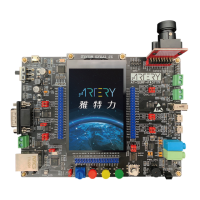Core: ARM
®
32-bit Cortex
®
-M4F CPU with FPU
− 216 MHz maximum frequency, with a Memory
Protection Unit (MPU), single-cycle multiplication
and hardware division
− Floating Point Unit (FPU)
− DSP instructions
Memories
− 128 to 256 Kbytes of Flash memory
− 20 Kbytes of boot memory used as a Bootloader or
as a general instruction/data memory (one-time
configured)
− sLib: configurable part of main Flash as a library
area with code executable but secured, non-
readable
− 70 to 102 Kbytes of SRAM
Power control (PWC)
− 2.4 V to 3.6 V power supply
− Power-on reset (POR)/low voltage reset (LVR), and
power voltage monitor (PVM)
− Low-power modes: Sleep, Deepsleep and Standby
modes
− 20 x 32-bit RTC data registers (BPR)
Clock and reset management (CRM)
− 4 to 25 MHz crystal (HEXT)
− 48 MHz internal factory-trimmed HICK (1% at
TA=25 °C, 2% at TA=-40 °C to +105 °C), with
automatic clock calibration (ACC)
− PLL with configurable frequency multiplication and
division factors
− 32.768 kHz crystal (LEXT)
− Low speed internal clock (LICK)
Analog
− 1 x 12-bit 2 MSPS A/D converter, up to 16 input
channels, hardware over-sampling up to equivalent
16-bit resolution
− Temperature sensor (V
TS
), internal reference voltage
(V
INTR
)
DMA
− 2 x 7-channel DMA controllers
Up to 56 fast GPIOs
− All mappable on 16 external interrupts
− Almost 5 V-tolerant
Up to 14 timers (TMR)
− 1 x 16-bit 4-channel advanced timer, each channel
PWM output with dead-time generator and
emergency break
− Up to 1 x 32-bit and 7 x 16-bit general-purpose
timers, each with 4 IC/OC/PWM or pulse counter
and incremental encoder input; including 5 timers
supporting complementary output with dead-time
generator and emergency brake
− 2 x 16-bit basic timers
− 2 x watchdog timers (WDT and WWDT)
− SysTick timer: 24-bit downcounter
ERTC: Enhanced RTC, with auto wakeup, alarm,
subsecond accuracy, hardware calendar, and
calibration feature
Up to 19 communication interfaces
− Up to 3 x I
2
C interfaces (SMBus/PMBus)
− Up to 8 x USARTs/UARTs (ISO7816 interface, LIN,
IrDA capability, modem control and RS485 drive
enable, TX/RX swap)
− 3 x SPIs, all with I
2
S interface multiplexed, any
combination of two interfaces support full-duplex,
with 1 full-duplex I
2
SF interface
− 1 x CAN interface (2.0B Active)
− USB2.0 FS/host/OTG device interface, supporting
crystal-less in device mode
− USB2.0 HS/host/OTG device interface
− 1 x QSPI
− Infrared transmitter (IRTMR)
CRC calculation unit
96-bit unique ID (UID)
Debug mode
− SWD interface
Operating temperature: -40 to +105 °C
Packages
− LQFP64 10 x 10 mm
− LQFP64 7 x 7 mm
− LQFP48 7 x 7 mm
− QFN48 6 x 6 mm
− QFN32 4 x 4 mm
List of models

